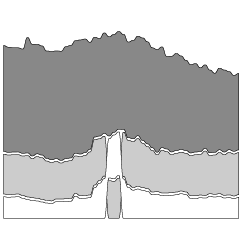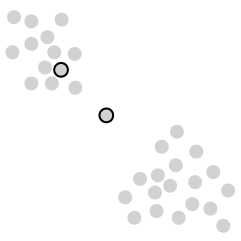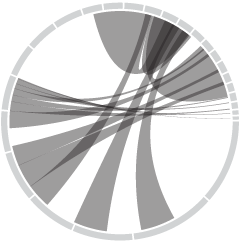We saw math principles in nature. Now how about charts? Andy Woodruff does some sniffing around in Google Maps to find charts in rural landscapes. Above, you’ve got your polar area charts in Bolivia. It looks like an agricultural area. I have no idea how that kind of layout would be more efficient than squares though. Then again, I’m no farmer. Other chart types include pies, bars, and treemaps. Can you find anymore?
-
This is completely useless in the good sort of way. Twitter parade, by KDDI, takes your followers and throws a parade for you. You can also enter a keyword instead of a username. As the people march, their recent tweets are displayed.
Thanks for the giant statue with the top half of my head, guys. Truly, the honor is all mine.
[via datavisualization]
-
COMING MAY 29
 Pre-order on Amazon
Pre-order on Amazon
-
Speaking of sports most Americans know nothing about, Robby Macdonell visualizes NHL Stanley Cup competitors in his experiment with HTML5. The interactive shows winners and losers since 1927. Teams are shown up top and years are on the bottom. Mouse over stuff, and connecting lines show past appearances if you are looking at a team, or the winner and loser of a year, if you are looking at the bottom.
See Robby’s post for the full skinny on how he did it.
Congratulations to the Chicago Blackhawks in their recent win. You’ve done Obama proud.
[via the forums]
-
I was born in and live in the United States, so to me football is a bunch of big guys in full armor trying to tackle each other. To the rest of the world though, all eyes are on the World Cup, starting June 11. So this is for you, international readers (and maybe one or two Americans). Marca has an interactive World Cup schedule so you can make sure not to miss any important matches. Mouse over a date, a team, a group/stage, or cities/stadiums to focus on the matches you want.
[Thanks, Judi]
-
The Deepwater Horizon well is nearly a mile deep in water. It extends 3.5 miles. It’s hard to imagine these depths of the ocean though since most of us have never gone further than twenty feet below. The New York Times’ Bill Marsh provides some context. The Titanic rests 2.4 miles down, while in 1960, a U.S. Navy submersible descended to the deepest known ocean floor, about 7 miles into the darkness. [Thanks, Peter]
-
In another look at the data from xkcd’s color experiment, Stephen Von Worley looks at the common and not so common colors of the rainbow:
The Color Strata includes the 200 most common color names (excluding black-white-grayish tones), organized by hue horizontally and relative usage vertically, stacked by overall popularity, shaded representatively, and labeled where possible. Besides filtering spam, ignoring cruft, normalizing grey to gray, and correcting the most egregious misspellings (here’s looking at you, fuchsia), the results are otherwise unadulterated.
The results correspond nicely with Martin and Dolores Labs’ color wheels from a couple of years ago.
[Thanks, Stephen]
-
Maps on the major sites like Yahoo, Google, and Bing have a similar look. You’ve got your yellow roads, orange freeways, and green parks. Bing Destination Maps takes a different approach. Select your region of interest, and choose the style that you want. You have four choices: European, American, sketchy, and treasure map (above).
Read More -
A couple of weeks ago you saw Eric Fischer’s maps of Flickr photos in major cities. The inclination was to think of the maps as a representation of tourist hot spots. The more pictures taken in an area, the more people go there to visit. That’s not necessarily the case though. Tourists might flock to an area and might completely neglect another, while locals might avoid the touristy areas.
In Fischer’s second run of maps, he makes an educated guess about the splits between tourists and locals:
Blue points on the map are pictures taken by locals (people who have taken pictures in this city dated over a range of a month or more).
Red points are pictures taken by tourists (people who seem to be a local of a different city and who took pictures in this city for less than a month).
Yellow points are pictures where it can’t be determined whether or not the photographer was a tourist (because they haven’t taken pictures anywhere for over a month). They are probably tourists but might just not post many pictures at all.
See the full set on Flickr. It’s even better than the first. [via | thanks, Joe]
-
Note: The review copy I received is in French. Unfortunately, I only understand English. So this review is actually my impression of Data Flow: Design Graphique et Visualisation D’Informations as a picture book with titles, which in a way it kind of is anyways.
Last year, the first Data Flow was published, featuring the data graphics of some fine designers. You can read my review of it here. Basically, if you liked the first Data Flow and could use some more inspiration, you’ll probably like this second edition. The two are really similar in layout and in the way the graphics are split up. The title is exactly the same, save the 2.
Read More -
While the US has its own problems with debt somewhere in the range of $13 trillion, European countries have got some issues too. It seems like everyone owes something these days.
[Thanks, Tom]
-
Doug McCune maps San Francisco crime in 2009 as if it were elevation. Peaks and valleys emerge with the rolling terrains of crime. The above is the map for prostitution:
My favorite map is the one for prostitution (maybe “favorite” is the wrong choice of words there). Nearly all the arrests for prostitution in San Francisco occur along what I’m calling the “Mission Mountain Ridge”, which runs up Mission St between 24th and 16th. I love the way the mountain range casts a shadow over much of the city. There’s also a second peak in the Tenderloin (which I’m dubbing Mt. Loin).
I love how realistic the 3-dimensional models look. They could almost pass for clay figures. Doug notes that the series of maps are more an art piece than they are information visualization, but these would be a great complement to your standard choropleth.
-
In regards to the UK’s recent boom in open data, Simon Rogers of the Guardian, ponders data’s role in journalism, and the opportunities this new found information could bring:
The impact on journalism is expected to be great. The Chicago-based web developer and founder of the neighbourhood news site EveryBlock, Adrian Holovaty, says it’s going to be challenging but exciting for journalists. “As more governments open their data, journalists lose privileged status as gatekeepers of information – but the need for their work as curators and explainers increases. The more data that’s available in the world, the more essential it is for somebody to make sense of it.”
This need not only creates a fresh brand of news, but also a new type of journalist:
I once prided myself on my lack of maths knowledge. Now I find myself editing a datajournalism site, the Guardian’s datablog: a site where we use Google Spreadsheets to post key datasets. We make the data properly accessible, then encourage our users to take the numbers, produce graphics and applications and help us look for stories.
Priding yourself on a lack of know-how on how to deal with data is a little weird, but okay.
In any case, people always ask me how to get into information design, infographics, visualization etc. Journalism is one of those choices, and there’s a lot of opportunity there if you’ve got the skills.
-
The most recent version of Protovis, the open-source visualization library that uses JavaScript and SVG, was just released not too long ago – this time with more layout and examples. This is especially helpful since Protovis was “designed to be learned by example.” Among the new stuff is the ever popular streamgraphs, along with the force-directed layout. With only 10 to 20 lines of code, you’ll have your viz, so lots of bang for the buck.
There are, however, still some limitations with dreaded Internet Explorer (mainly with interaction), but they’re getting there, I think.
Find plenty of other examples on the Protovis site. Robert Kosara has also started a series of Protovis tutorials on how to use the library if you want some guidance on where to start.
-
Excited about the 2010 MTV Movie Awards? Yeah, me neither. But if you want to keep an eye on things while you watch or do something else (you know, in case there’s a Kanye moment), MTV and Stamen provide a tweet tracker for the event. Similar to the VMA tracker last year, movies and celebrities are highlighted based on tweets about them per minute. The look, feel, and views are different, however.
Read More -
BP processes about 1.5 million barrels of crude oil per day, across six refineries in the United States. In total, 150 refineries in the United States process just under 18 million barrels per day, so BP processes about 8.5 percent of it. However, as reported by the Center for Public Integrity, 97 percent of the most dangerous violations found by OSHA were on BP properties.
Read More -
You’ve heard about the struggling musician. It’s a tough business. How tough is it though? David McCandless of Information is Beautiful, looks at how much musicians make from major online outlets. Bubbles are sized by how many sales or plays a song must get before someone makes US monthly minimum wage.
Read More -
Alice Rawsthorn for The New York Times reports on Charles Booth’s London poverty maps, from the late 1800s, currently on display at the Museum of London. During a time when people saw rich and poor living separately, Booth’s map showed the contrary:
Mr. Booth had set out to discover how many people were living in poverty, to determine why and what could be done to help them. As well as proving that there was much more poverty in London than the official statistics suggested, his research revealed the nuances of an increasingly complex city with different degrees of hardship, where the rich often lived alongside the poor.
Of course, no visualization-related piece is complete without a little bit of data overload melodrama and a hat tip to Processing:
As the data crisis worsens, finding new ways to make sense of this tsunami of information and to illustrate it clearly becomes ever more urgent. One solution is data visualization, a new visual language now being developed by information designers. Using sophisticated programming languages, like Processing, they are distilling colossal quantities of baffling data into seductive digital animations — or visualizations — many of which then change in real time to reflect what is actually happening.
Ah, that hit the spot.
[via]
-
Norman Nie, co-creator of SPSS (acquired by IBM for $1.2 billion last summer), and his group Revolution Analytics aim to bring analysis to a wider audience with a product built on top of R, the popular statistical computing language. They call it Revolution R.
Noted in a recent Forbes article:
R is a powerful tool but difficult for novices to use. Nie’s Revolution Analytics aims to make it more accessible with a better-organized library, capabilities for bigger jobs and a user interface that lets users drag and drop statistical analyses into place, outputting easily read charts.
The rest of the article is about Nie, the growing importance of data, etc.
I’m curious. Has anyone tried Revolution R? They say that it has “faster performance and greater stability” than base R. Is it that much better?
[Thanks, Victoria]
-
If it Was My Home is a simple but effective concept. Enter your location, and the oil spill is overlayed on top. It’s gotten to the point where the area the spill covers is greater than the area of some states. Scared? You should be.
-
It’s fun to imagine the future. Every few months, someone takes a stab with a concept video or a proof of concept prototype, providing a glimpse into human-computer interaction and data visualization in a decade or two. What will it really look like? It’s anyone’s guess. But if people’s imaginations are any indication, the future will be filled of data displays and 3-dimensional holographic objects projected into physical space.
Read More














 Visualize This: The FlowingData Guide to Design, Visualization, and Statistics
Visualize This: The FlowingData Guide to Design, Visualization, and Statistics










